Learning Kernel Perceptrons on Noisy Data and Random Projections
Learning Kernel Perceptrons on Noisy Data and Random Projections
Learning Kernel Perceptrons on Noisy Data and Random Projections
You also want an ePaper? Increase the reach of your titles
YUMPU automatically turns print PDFs into web optimized ePapers that Google loves.
<str<strong>on</strong>g>Learning</str<strong>on</strong>g> <str<strong>on</strong>g>Kernel</str<strong>on</strong>g> <str<strong>on</strong>g>Perceptr<strong>on</strong>s</str<strong>on</strong>g> <strong>on</strong> <strong>Noisy</strong> <strong>Data</strong> <strong>and</strong><br />
R<strong>and</strong>om Projecti<strong>on</strong>s<br />
Guillaume Stempfel, Liva Ralaivola<br />
Laboratoire d’Informatique F<strong>on</strong>damentale de Marseille, UMR CNRS<br />
6166<br />
Université de Provence, 39, rue Joliot Curie, 13013 Marseille, France<br />
{guillaume.stempfel,liva.ralaivola}@lif.univ-mrs.fr<br />
Abstract<br />
In this paper, we address the issue of learning n<strong>on</strong>linearly separable c<strong>on</strong>cepts<br />
with a kernel classifier in the situati<strong>on</strong> where the data at h<strong>and</strong> are altered by a uniform<br />
classificati<strong>on</strong> noise. Our proposed approach relies <strong>on</strong> the combinati<strong>on</strong> of the<br />
technique of r<strong>and</strong>om or deterministic projecti<strong>on</strong>s with a classificati<strong>on</strong> noise tolerant<br />
perceptr<strong>on</strong> learning algorithm that assumes distributi<strong>on</strong>s defined over finitedimensi<strong>on</strong>al<br />
spaces. Provided a sufficient separati<strong>on</strong> margin characterizes the<br />
problem, this strategy makes it possible to envisi<strong>on</strong> the learning from a noisy distributi<strong>on</strong><br />
in any separable Hilbert space, regardless of its dimensi<strong>on</strong>; learning with<br />
any appropriate Mercer kernel is therefore possible. We prove that the required<br />
sample complexity <strong>and</strong> running time of our algorithm is polynomial in the classical<br />
PAC learning parameters. Numerical simulati<strong>on</strong>s <strong>on</strong> toy datasets <strong>and</strong> <strong>on</strong> data<br />
from the UCI repository support the validity of our approach.<br />
Keywords: <str<strong>on</strong>g>Kernel</str<strong>on</strong>g> Classifier, R<strong>and</strong>om Projecti<strong>on</strong>s, Classificati<strong>on</strong> Noise, Perceptr<strong>on</strong><br />
1 Introducti<strong>on</strong><br />
For a couple of years, it has been known that kernel methods (Schölkopf & Smola,<br />
2002) provide a set of efficient techniques <strong>and</strong> associated models for, am<strong>on</strong>g others,<br />
classificati<strong>on</strong>. In additi<strong>on</strong>, str<strong>on</strong>g theoretical results (see, e.g. (Vapnik, 1995; Cristianini<br />
& Shawe-Taylor, 2000)), mainly based <strong>on</strong> margin criteria <strong>and</strong> the fact they c<strong>on</strong>stitute<br />
a generalizati<strong>on</strong> of the well-studied class of linear separators, support the relevance<br />
of their use.<br />
Ast<strong>on</strong>ishingly enough however, there is, to our knowledge, very little work <strong>on</strong> the<br />
issue of learning noisy distributi<strong>on</strong>s with kernel classifiers, a problem which is of great<br />
interest if <strong>on</strong>e aims at using kernel methods <strong>on</strong> real-world data. Assuming a uniform<br />
classificati<strong>on</strong> noise process (Angluin & Laird, 1988), the problem of learning from<br />
noisy distributi<strong>on</strong>s is a key challenge in the situati<strong>on</strong> where the feature space associated<br />
with the chosen kernel is of infinite dimensi<strong>on</strong>, knowing that approaches to learn noisy<br />
1
linear classifiers in finite dimensi<strong>on</strong> do exist (Byl<strong>and</strong>er, 1994; Blum et al., 1996; Cohen,<br />
1997; Byl<strong>and</strong>er, 1998).<br />
In this work, we propose an algorithm to learn noisy distributi<strong>on</strong>s defined <strong>on</strong> general<br />
Hilbert spaces, not necessarily finite dimensi<strong>on</strong>al) from a reas<strong>on</strong>able number of<br />
data (where reas<strong>on</strong>able will be specified later <strong>on</strong>); this algorithm combines the technique<br />
of r<strong>and</strong>om projecti<strong>on</strong>s with a known finite-dimensi<strong>on</strong>al noise-tolerant linear classifier.<br />
The paper is organized as follows. In Secti<strong>on</strong> 2, the problem setting is depicted<br />
together with the classificati<strong>on</strong> noise model assumed. Our strategy to learn kernel<br />
classifiers from noisy distributi<strong>on</strong>s is described in Secti<strong>on</strong> 3. Secti<strong>on</strong> 4 reports some<br />
c<strong>on</strong>tributi<strong>on</strong>s related to the questi<strong>on</strong>s of learning noisy perceptr<strong>on</strong>s <strong>and</strong> learning kernel<br />
classifiers using projecti<strong>on</strong>s methods. Numerical simulati<strong>on</strong>s carried out <strong>on</strong> synthetical<br />
datasets <strong>and</strong> <strong>on</strong> benchmark datasets from the UCI repository proving the effectiveness<br />
of our approach are presented in Secti<strong>on</strong> 5.<br />
2 Problem Setting <strong>and</strong> Main Result<br />
Remark 1 (Binary classificati<strong>on</strong> in Hilbert spaces, Zero-bias perceptr<strong>on</strong>). From now<br />
<strong>on</strong>, X denotes the input space, assumed to be a Hilbert space equipped with an inner<br />
product denoted by ·. In additi<strong>on</strong>, we will restrict our study to the binary classificati<strong>on</strong><br />
problem <strong>and</strong> the target space Y will henceforth always be {−1, +1}.<br />
We additi<strong>on</strong>ally make the simplifying assumpti<strong>on</strong> of the existence of zero-bias separating<br />
hyperplanes (i.e. hyperplanes defined as w · x = 0).<br />
2.1 <strong>Noisy</strong> <str<strong>on</strong>g>Perceptr<strong>on</strong>s</str<strong>on</strong>g> in Finite Dimensi<strong>on</strong><br />
The Perceptr<strong>on</strong> algorithm (Rosenblatt,<br />
1958) (cf. Fig. 1) is a wellstudied<br />
greedy strategy to derive a<br />
linear classifier from a sample S =<br />
{(x 1 , y 1 )...(x m , y m )} of m labeled<br />
pairs (x i , y i ) from X ×Y. which are<br />
assumed to be drawn independently<br />
from an unknown <strong>and</strong> fixed distributi<strong>on</strong><br />
D over X × Y. If there exists<br />
a separating hyperplane w ∗ · x = 0<br />
according to which the label y of x<br />
is set, i.e. y is set to +1 if w ∗·x ≥ 0<br />
Input: S = {(x 1 , y 1 )...(x m , y m )}<br />
Output: a linear classifier w<br />
t ← 0<br />
w 0 ← 0<br />
while there is i s.t. y i w t · x i ≤ 0 do<br />
w t+1 ← w t + y i x i /‖x i ‖<br />
t ← t + 1<br />
end while<br />
return w<br />
Figure 1: Perceptr<strong>on</strong> algorithm.<br />
<strong>and</strong> −1 otherwise 1 , then the Perceptr<strong>on</strong> algorithm, when given access to S, c<strong>on</strong>verges<br />
towards an hyperplane w that correctly separates S <strong>and</strong> might with high probability<br />
exhibit good generalizati<strong>on</strong> properties (Graepel et al., 2001).<br />
We are interested in the possibility of learning linearly separable distributi<strong>on</strong>s <strong>on</strong><br />
which a r<strong>and</strong>om uniform classificati<strong>on</strong> noise process, denoted as CN (Angluin & Laird,<br />
1988), has been applied, that is, distributi<strong>on</strong>s where correct labels are flipped with some<br />
given probability η. In order to solve this problem, Byl<strong>and</strong>er (1994) has proposed<br />
1 we assume a deterministic labelling of the data according to the target hyperplane w ∗ , i.e. Pr(y =<br />
1|x) = 1 or Pr(y = 1|x) = 0, but a n<strong>on</strong>deterministic setting can be h<strong>and</strong>led as well.<br />
2
Algorithm 1 RP-classifier<br />
Input: • S = {(x 1 , y 1 )...(x m , y m )} in X × {−1, +1}<br />
• n, projecti<strong>on</strong> dimensi<strong>on</strong><br />
Output: • a r<strong>and</strong>om projecti<strong>on</strong> π = π(S, n) : X → X ′ , X ′ = span〈x i1 , . . . ,x in 〉<br />
• projecti<strong>on</strong> classifier f(x) = w · π(x), w ∈ X ′<br />
learn an orth<strong>on</strong>ormal r<strong>and</strong>om projecti<strong>on</strong> π : X → X ′<br />
learn a linear classifier w from S = {(π(x 1 ), y 1 )...(π(x m ), y m )}<br />
return π, w<br />
a simple algorithmic strategy later exploited by Blum et al. (1996): it c<strong>on</strong>sists in an<br />
iterative learning process built up<strong>on</strong> the Perceptr<strong>on</strong> algorithm where update vectors<br />
are computed as sample averages of training vectors fulfilling certain properties. The<br />
expectati<strong>on</strong>s of those update vectors guarantee the c<strong>on</strong>vergence of the learning process<br />
<strong>and</strong>, thanks in part to Theorem 1 stated just below, it is guaranteed with probability<br />
1 − δ (for δ ∈ (0, 1)) that whenever the dimensi<strong>on</strong> n of X is finite <strong>and</strong> there exists<br />
a separating hyperplane of margin γ > 0, a polynomial number of training data is<br />
sufficient for the sample averages to be close enough to their expectati<strong>on</strong>s; this, in turn<br />
implies a polynomial running time complexity of the algorithm together with a 1 − δ<br />
guarantees for a generalizati<strong>on</strong> error of ε. Here, polynomiality is defined with respect<br />
to n, 1/δ, 1/ε, 1/γ <strong>and</strong> 1/(1 − 2η).<br />
Theorem 1 (Vapnik (1998)). If F = {f ϕ (x)|ϕ ∈ Φ} has a pseudo-dimensi<strong>on</strong> of h <strong>and</strong><br />
a range R (i.e. |f ϕ (x)| ≤ R for any ϕ <strong>and</strong> x), <strong>and</strong> if a r<strong>and</strong>om sample of<br />
)<br />
M ≥ m 0 (h, R, δ, ε) = 8R2 ( 2h ln 4R ε + ln 9 δ<br />
i.i.d examples are drawn from a fixed distributi<strong>on</strong>, then with probability 1 − δ, the<br />
sample average of every indicator functi<strong>on</strong> f ϕ (x) > α is within ε R<br />
of its expected<br />
value, <strong>and</strong> the sample average of every f ϕ is within ε of its expected value. (The<br />
pseudo-dimensi<strong>on</strong> of F is the VC dimensi<strong>on</strong> of {f ϕ (x) > α|ϕ ∈ Φ ∧ α ∈ R}.)<br />
2.2 Main Result: RP Classifiers <strong>and</strong> Infinite-Dimensi<strong>on</strong>al Spaces<br />
In light of what we have just seen, the questi<strong>on</strong> that naturally arises is whether it is<br />
possible to learn linear classifiers from noisy distributi<strong>on</strong>s defined over infinite dimensi<strong>on</strong>al<br />
spaces with similar theoretical guarantees with respect to the polynomiality of<br />
sample <strong>and</strong> running time complexities. We answer to this questi<strong>on</strong> positively by exhibiting<br />
a family of learning algorithm called r<strong>and</strong>om projecti<strong>on</strong> classifiers capable of<br />
doing so. Classifiers of this family learn from a training sample S according to Algorithm<br />
1: given a finite projecti<strong>on</strong> dimensi<strong>on</strong> n, they first learn a projecti<strong>on</strong> π from X to<br />
a space X ′ spanned by n (r<strong>and</strong>omly chosen) vectors of S dimensi<strong>on</strong>al space <strong>and</strong> then,<br />
learn a finite dimensi<strong>on</strong>al noisy perceptr<strong>on</strong> from the labeled data projected according to<br />
π. An instanciati<strong>on</strong> of RP-classifiers simply c<strong>on</strong>sists in a choice of a r<strong>and</strong>om projecti<strong>on</strong><br />
learning algorithm <strong>and</strong> of a (noise-tolerant) linear classifier.<br />
Let us more formally introduce some definiti<strong>on</strong>s <strong>and</strong> state our main result.<br />
ε 2<br />
3
Remark 2 (Labeled Examples Normalizati<strong>on</strong>). In order to simplify the definiti<strong>on</strong>s <strong>and</strong><br />
the writing of the proofs we will use the h<strong>and</strong>y transformati<strong>on</strong> that c<strong>on</strong>sists in c<strong>on</strong>verting<br />
every labeled example (x, y) to yx/‖x‖. From know <strong>on</strong> we will therefore c<strong>on</strong>sider<br />
distributi<strong>on</strong>s <strong>and</strong> samples defined <strong>on</strong> X (instead of X × Y).<br />
Note that the transformati<strong>on</strong> does not change the difficulty of the problem <strong>and</strong> that<br />
the seek for a separating hyperplane between +1 <strong>and</strong> -1 classes boils down to the<br />
search for a hyperplane w verifying w · x > 0.<br />
Definiti<strong>on</strong> 1 ((γ, ε)-separable distributi<strong>on</strong>s D γ,ε ). For γ > 0, ε ∈ [0, 1), D γ,ε is the<br />
set of distributi<strong>on</strong>s <strong>on</strong> X such that for any D in D γ,ε , there exists a vector w in X such<br />
that Pr x∼D [w · x < γ] ≤ ε.<br />
Definiti<strong>on</strong> 2 (CN distributi<strong>on</strong>s U γ,η (Angluin & Laird, 1988)). For η ∈ [0, 0.5), let<br />
the r<strong>and</strong>om transformati<strong>on</strong> U η which maps an example x to −x with probability η <strong>and</strong><br />
leaves it unchanged with probability 1 − η.<br />
The set of distributi<strong>on</strong>s U γ,η is defined as U γ,η := U η (D γ,0 ).<br />
We can now state our main result:<br />
Theorem 2 (Dimensi<strong>on</strong>-Independent Learnability of <strong>Noisy</strong> <str<strong>on</strong>g>Perceptr<strong>on</strong>s</str<strong>on</strong>g>). There exists<br />
an algorithm A <strong>and</strong> polynomials p(·, ·, ·, ·) <strong>and</strong> q(·, ·, ·, ·) such that the following holds<br />
true.<br />
∀ε ∈ (0, 1), ∀δ ∈ (0, 1), ∀γ > 0, ∀η ∈ [0, 0.5), ∀D ∈ D γ,0 , if a r<strong>and</strong>om sample<br />
S = {x 1 , . . . ,x m } with m ≥ p( 1 ε , 1 δ , 1<br />
1−2η , 1 γ ) is drawn from Uη (D), then with probability<br />
at least 1 − δ, A runs in time q( 1 ε , 1 δ , 1<br />
1−2η , 1 γ<br />
) <strong>and</strong> the classifier f := A(S)<br />
output by A has a generalizati<strong>on</strong> error Pr x∼D (f(x) ≤ 0) bounded by ε.<br />
3 Combining R<strong>and</strong>om Projecti<strong>on</strong>s <strong>and</strong> a Noise-Tolerant<br />
<str<strong>on</strong>g>Learning</str<strong>on</strong>g> Algorithm<br />
This secti<strong>on</strong> gives a proof of Theorem 2 by showing that an instance of RP-classifier<br />
using a linear learning algorithm based <strong>on</strong> a specific perceptr<strong>on</strong> update rule, Cnoiseupdate,<br />
proposed by Byl<strong>and</strong>er (1998) <strong>and</strong> <strong>on</strong> properties of simple r<strong>and</strong>om projecti<strong>on</strong>s<br />
proved by Balcan et al. (2004) is capable of efficiently learning CN distributi<strong>on</strong>s (Dee<br />
definiti<strong>on</strong> 2) independently of the dimensi<strong>on</strong> of the input space.<br />
The proof works in two steps. First, in secti<strong>on</strong> 3.1, we show that Cnoise-update<br />
(see Algorithm 2) in finite dimensi<strong>on</strong> can tolerate a small amount of malicious noise<br />
<strong>and</strong> still return relevant update vectors. Then, in secti<strong>on</strong> 3.2, thanks to properties of<br />
r<strong>and</strong>om projecti<strong>on</strong>s (see (Balcan et al., 2004)) we show that r<strong>and</strong>om projecti<strong>on</strong>s can be<br />
efficiently used to transform a CN noisy problem into <strong>on</strong>e that meets the requirements<br />
of Cnoise-update (<strong>and</strong> Theorem 4 below).<br />
3.1 Perceptr<strong>on</strong> <str<strong>on</strong>g>Learning</str<strong>on</strong>g> with Mixed Noise<br />
As said earlier, we suppose in this subsecti<strong>on</strong> that X if of finite dimensi<strong>on</strong> n. We will<br />
make use of the following definiti<strong>on</strong>s.<br />
4
Algorithm 2 Cnoise-Update (Byl<strong>and</strong>er, 1998)<br />
Input: • S: training data<br />
• w: current weight vector<br />
• ν a n<strong>on</strong>negative real value<br />
Output: an update vector z<br />
µ ← 1<br />
|S|<br />
∑<br />
x∈S<br />
x, µ ′ ← 1<br />
|S|<br />
if w · µ ≤ ν ‖w‖ then<br />
z ← µ<br />
else<br />
a ← w · µ − ν ‖w‖<br />
w · µ − w · µ ′ ,<br />
z ← aµ ′ + bµ<br />
end if<br />
/* projecti<strong>on</strong> step */<br />
if w · z > 0 then<br />
z ← z − w w · z<br />
w · w<br />
end if<br />
return z<br />
∑<br />
x∈S∧w·x≤0<br />
x<br />
b ← −w · µ′ + ν ‖w‖<br />
w · µ − w · µ ′<br />
Definiti<strong>on</strong> 3 (Sample <strong>and</strong> populati<strong>on</strong> accuracies). Let w a unit vector, D a distributi<strong>on</strong><br />
<strong>on</strong> X <strong>and</strong> S a sample drawn from D. We say that w has sample accuracy 1 − ε <strong>on</strong> S<br />
<strong>and</strong> (populati<strong>on</strong>) accuracy 1 − ε ′ if:<br />
Pr x∈S [w · x < 0] = ε, <strong>and</strong> Pr x∼D [w · x < 0] = ε ′<br />
Definiti<strong>on</strong> 4 (CN-c<strong>on</strong>sistency). A unit weight vector w ∗ is CN-c<strong>on</strong>sistent <strong>on</strong> D ∈ U γ,η<br />
if Pr x∼D [w ∗ · x < γ] = η. This means thatw makes no error <strong>on</strong> the noise free versi<strong>on</strong><br />
of D.<br />
We recall that according to the following theorem (Byl<strong>and</strong>er, 1998), Cnoise-updaate,<br />
depicted in Algorithm 2, when used in a perceptr<strong>on</strong>-like iterative procedure, renders the<br />
learning of CN-distributi<strong>on</strong> possible in finite dimensi<strong>on</strong>.<br />
Theorem 3 (Byl<strong>and</strong>er (1998)). Let γ ∈ [0, 1], η ∈ [0, 0.5), ε ∈ (0, 1( − 2η]. Let D ∈ )<br />
U γ,η . Ifw ∗ is CN-c<strong>on</strong>sistent <strong>on</strong> D, if a r<strong>and</strong>om sample S of m ≥ m 0 10(n + 1), 2, δ,<br />
εγ<br />
4<br />
examples are drawn from D <strong>and</strong> if the perceptr<strong>on</strong> algorithm uses update vectors from<br />
Cnoise-Update(S,w t , εγ 16<br />
4<br />
) for more than<br />
(εγ)<br />
updates <strong>on</strong> these points, then the w 2 t<br />
with the highest sample accuracy has accuracy at least 1−η−ε with probability 1−δ 2 .<br />
The questi<strong>on</strong> that is of interest to us deals with a little bit more general situati<strong>on</strong><br />
that simple CN noise. We would like to show that Cnoise-update is still applicable<br />
when, in additi<strong>on</strong> to being CN, the distributi<strong>on</strong> <strong>on</strong> which it is called is also corrupted by<br />
malicious noise (Kearns & Li, 1993), i.e. a noise process whose statistical properties<br />
2 Here, <strong>and</strong> for the remaining of the paper, ε is not the usual error parameter ε ′ used in PAC, but ε ′ (1−2η).<br />
5
cannot be exploited in learning (this is an ‘uncompressible’ noise). Envisi<strong>on</strong>ing this<br />
situati<strong>on</strong> is motivated by the projecti<strong>on</strong> step, which may introduce some amount of<br />
projecti<strong>on</strong> noise (cf. Theorem 5), that we treat as malicious noise.<br />
Of course, a limit <strong>on</strong> the amount of malicious noise must be enforced if some<br />
reas<strong>on</strong>able generalizati<strong>on</strong> error is to be achieved. Working with distributi<strong>on</strong>s from<br />
U γ,η we therefore set θ max (γ, η) = γ(1−2η)<br />
8<br />
as the maximal amount tolerated by the<br />
algorithm. For θ ≤ θ max , a minimal achievable error rate ε min (γ, η, θ) =<br />
64θ<br />
γ(1−η)( 1 8 −θ)<br />
will be our limit 3 . Provided that the amount of malicious noise is lower than θ max , we<br />
show that learning can be achieved for any error ε ≥ ε min (γ, η, θ). The proof n<strong>on</strong><br />
trivially extends that of Byl<strong>and</strong>er (1998) <strong>and</strong> roughly follows its lines.<br />
Definiti<strong>on</strong> 5 (Mixed-Noise distributi<strong>on</strong>s, U γ,η θ ). For θ ∈ [0, 1), let the r<strong>and</strong>om transformati<strong>on</strong><br />
U θ which leaves an input x unchanged with probability 1 − θ <strong>and</strong> changes<br />
it to any arbitrary x ′ with probability θ (nothing can be said about x ′ ).<br />
The set of distributi<strong>on</strong>s U γ,η,θ is defined as U γ,η,θ := U θ ( U η (D γ,0 ) ) .<br />
Remark 3 (CN <strong>and</strong> MN decompositi<strong>on</strong>). For γ > 0, η ∈ [0, 0.5), θ ∈ [0, 1), the image<br />
distributi<strong>on</strong> D γ,η,θ := U θ ( U η (D γ,0 ) ) of D γ,0 ∈ D γ,0 is therefore a mixture of two<br />
distributi<strong>on</strong>s: the first <strong>on</strong>e, of weight 1−θ, is a CN distributi<strong>on</strong> with noise η <strong>and</strong> margin<br />
γ while nothing can be said about the sec<strong>on</strong>d, of weight θ. This latter distributi<strong>on</strong> will<br />
be referred to as the malicious part (MN) of D γ,η,θ .<br />
In order to account for the malicious noise, we introduce the r<strong>and</strong>om variable θ :<br />
X → {0, 1} such that θ(x) = 1 if x is altered by malicious noise <strong>and</strong> θ(x) = 0<br />
otherwise.<br />
From now <strong>on</strong>, we will use E [f(x)] for E x∼D [f(x)] <strong>and</strong> Ê [f(x)] for E x∈S [f(x)].<br />
Lemma 1. Let γ > 0, η ∈ [0, 0.5) <strong>and</strong> δ ∈ (0, 1). Let θ ∈ [0, θ max (γ, η)) such that<br />
ε min (γ, η, θ) < 1, ε ∈ (ε min (γ, η, θ), 1] <strong>and</strong> D ∈ D γ,η,θ . Let m ′ > 1. If a sample S<br />
of size m ≥ m 1 (m ′ , γ, θ, ε, δ) = m ′ 642 ln 2 2(1−θ− εγ<br />
64)(εγ) 2 δ<br />
is drawn from D then, with<br />
probability 1 − δ:<br />
1 ∑<br />
1.<br />
θ(x) − E [θ(x)]<br />
∣m<br />
∣ ≤ εγ 2. |{x ∈ S|θ(x) = 0}| > m ′ .<br />
64<br />
x∈S<br />
Proof. Simple Chernoff bounds arguments prove the inequalities. (It suffices to observe<br />
that 1 ∑<br />
m x∈S θ(x) = Ê [θ(x)] <strong>and</strong> ∑ x∈S<br />
θ(x) = m − |{x ∈ S|θ(x) = 0}|.)<br />
Definiti<strong>on</strong> 6 (CN-c<strong>on</strong>sistency <strong>on</strong> Mixed-Noise distributi<strong>on</strong>s). Let γ > 0, η ∈ [0, 0.5), θ ∈<br />
[0, θ max (γ, η)). Let D ∈ U γ,η,θ . A hyperplanew ∗ is CN-c<strong>on</strong>sistent if Pr x∼D [w ∗ · x ≤ γ|θ(x) = 0] =<br />
η<br />
The next lemma says how much the added malicious noise modify the sample averages<br />
<strong>on</strong> the CN part of a distributi<strong>on</strong>.<br />
3 Slightly larger amount of noise <strong>and</strong> smaller error rate could be theoretically targeted. But the choices<br />
we have made suffice to our purpose.<br />
6
Lemma 2. Let γ > 0, η ∈ [0, 0.5) <strong>and</strong> δ ∈ (0, 1]. Let θ ∈ [0, θ max (γ, η)) such<br />
that ε min (γ, η, θ) < 1 −( 2η, <strong>and</strong> ( ε ∈ (ε min (γ, η, θ), 1 − 2η]. Let D ∈ U γ,η,θ . Let<br />
M (n, γ, η, θ, ε, δ) = m 1 m0 10(n + 1), 2,<br />
3δ<br />
4 , εγ )<br />
16 , γ, θ, ε,<br />
δ<br />
4)<br />
<strong>and</strong> w a unit vector.<br />
If S is a sample of size m > M (n, γ, η, θ, ε, δ) drawn from D then, with probability<br />
1 − δ, ∀R ∈ [−1, 1]:<br />
∣<br />
∣Ê[(w · x)1l ≤R(w · x)] − E[(w · x)1l ≤R (w · x)] ∣ ≤ εγ 8<br />
where 1l ≤R (α) = 1 if α ≤ R <strong>and</strong> 0 otherwise.<br />
(<br />
Proof. By Lemma 1, we know that |{x ∈ S|θ(x) = 0}| > m 0 10(n + 1), 2,<br />
3δ<br />
4 , εγ )<br />
16<br />
with probability 1 − 3δ<br />
3δ<br />
4<br />
. So, by Theorem 1, with probability 1 −<br />
4 − δ 4<br />
, ∀R ∈ [−1, 1]<br />
˛<br />
˛Ê ˆ(w · x)1l ≤R (w · x)|θ(x) = 0˜ − E ˆ(w εγ<br />
· x)1l ≤R (w · x)|θ(x) = 0˜˛˛˛ ≤ (1)<br />
16<br />
In additi<strong>on</strong>, we have<br />
˛<br />
˛Ê[(w · x)1l ≤R(w · x)] − E[(w · x)1l ≤R (w · x)] ˛<br />
˛<br />
= ˛Ê[(w · x)1l ≤R(w · x)|θ(x) = 0]Pr x∈S [θ(x) = 0] − E[(w · x)1l ≤R (w · x)|θ(x) = 0]Pr x∼D [θ(x) = 0]<br />
+ Ê[(w · x)1l ≤R(w · x)|θ(x) = 1]Pr x∈S [θ(x) = 1] − E[(w · x)1l ≤R (w · x)|θ(x) = 1]Pr x∼D [θ(x) = 1] ˛<br />
˛<br />
= ˛Ê[(w · x)1l ≤R(w · x)|θ(x) = 0] (Pr x∈S [θ(x) = 0] − Pr x∼D [θ(x) = 0])<br />
”<br />
+<br />
“Ê[(w · x)1l≤R (w · x)|θ(x) = 0] − E[(w · x)1l ≤R (w · x)|θ(x) = 0] Pr x∼D [θ(x) = 0]<br />
+ Ê[(w · x)1l ≤R(w · x)|θ(x) = 1] (Pr x∈S [θ(x) = 1] − Pr x∼D [θ(x) = 1])<br />
+<br />
“Ê[(w · x)1l≤R (w · x)|θ(x) = 1] − E[(w · x)1l ≤R (w · x)|θ(x) = 1]”<br />
Pr x∼D [θ(x) = 1] ˛<br />
˛<br />
= ˛Ê[(w · x)1l ≤R(w · x)|θ(x) = 0] ˛ |Pr x∈S [θ(x) = 0] − Pr x∼D [θ(x) = 0]|<br />
(≤ εγ by lemma 1)<br />
64 ˛<br />
+ ˛Ê[(w · x)1l ≤R(w · x)|θ(x) = 0] − E[(w · x)1l ≤R (w · x)|θ(x) = 0] ˛ Pr x∼D [θ(x) = 0]<br />
(≤ εγ by equati<strong>on</strong> 1)<br />
16 ˛<br />
+ ˛Ê[(w · x)1l ≤R(w · x)|θ(x) = 1] ˛ |Pr x∈S [θ(x) = 1] − Pr x∼D [θ(x) = 1]|<br />
(≤ εγ by lemma 1)<br />
64 ˛<br />
+ ˛Ê[(w · x)1l ≤R(w · x)|θ(x) = 1] − E[(w · x)1l ≤R (w · x)|θ(x) = 1] ˛ Pr x∼D [θ(x) = 1]<br />
≤ 1 × εγ<br />
64 + ε<br />
εγ<br />
(1 − θ) + 1 × + 2θ (with probability 1 − δ)<br />
16 64<br />
≤ 6ε<br />
64 + 2θ<br />
≤ 2ε<br />
(according to the values of ε min <strong>and</strong> θ max)<br />
The following lemma shows that a CN-c<strong>on</strong>sistent vector w ∗ allows for a positive<br />
expectati<strong>on</strong> of w ∗ · x over a Mixed-Noise distributi<strong>on</strong>.<br />
Lemma 3. Let γ > 0, η ∈ [0, 0.5), θ ∈ [0, θ max (γ, η)). Suppose that D ∈ U γ,η,θ . If<br />
w ∗ is CN-c<strong>on</strong>sistent <strong>on</strong> the CN-part of D, then E [w ∗ · x] ≥ (1 − 2η)(1 − θ)γ − θ ><br />
0.<br />
7
Proof.<br />
E [w ∗ · x] = E [w ∗ · x|θ(x) = 0] Pr (θ(x) = 0) + E [w ∗ · x|θ(x) = 1] Pr (θ(x) = 1)<br />
= E [w ∗ · x|θ(x) = 0] (1 − θ) + E [w ∗ · x|θ(x) = 1] θ<br />
≥ E [w ∗ · x|θ(x) = 0] (1 − θ) − θ ≥ (1 − 2η) (1 − θ) γ − θ<br />
It is easy to check that the lower bound is strictly positive.<br />
We extend the 2 inequalities of Lemma 6 (cf. Appendix) to the case of a Mixed-<br />
Noise distributi<strong>on</strong>.<br />
Lemma 4. Let γ > 0, η ∈ [0, 0.5) <strong>and</strong> δ ∈ (0, 1]. Let θ ∈ [0, θ max (γ, η)) such that<br />
ε min (γ, η, θ) < 4(1−2η)<br />
3<br />
, <strong>and</strong> ε ∈ (ε min (γ, η, θ), 4(1−2η)<br />
3<br />
]. Let D ∈ U γ,η,θ . Let w be<br />
an arbitrary weight vector <strong>and</strong> D ∈ U γ,η,θ . If w ∗ is CN-c<strong>on</strong>sistent <strong>on</strong> the CN part<br />
of D, <strong>and</strong> if w has accuracy 1 − η − 3ε<br />
4<br />
<strong>on</strong> the CN part of D, then the following<br />
inequalities hold:<br />
(1 − 2η) E [(w ∗ · x)1l ≤0 (w · x)] + ηE [w ∗ · x]≥ 5εγ<br />
8<br />
(2)<br />
(1 − 2η) E [(w · x)1l ≤0 (w · x)] + ηE [w · x] ≤ηθ (3)<br />
Proof. For the first inequality, we have:<br />
(1 − 2η) E ˆ(w ∗ · x)1l ≤0 (w · x)˜ + ηE [w ∗ · x]<br />
= (1 − 2η) E ˆ(w ∗ · x)1l ≤0 (w · x)|θ(x) = 1˜ Pr [θ(x) = 1]<br />
+ ηE [w ∗ · x|θ(x) = 1] Pr [θ(x) = 1]<br />
+ (1 − 2η) E ˆ(w ∗ · x)1l ≤0 (w · x)|θ(x) = 0˜ Pr [θ(x) = 0]<br />
+ ηE [w ∗ · x|θ(x) = 0] Pr [θ(x) = 0]<br />
≥ (1 − θ) 3 εγ (by lemma 6 eq. 4)<br />
4<br />
+ (1 − 2η) E ˆ(w ∗ · x)1l ≤0 (w · x)|θ(x) = 1˜ Pr [θ(x) = 1]<br />
+ ηE [w ∗ · x| θ(x) = 1]Pr [θ(x) = 1]<br />
≥ (1 − θ) 3 εγ − (1 − 2η) θ − ηθ<br />
4<br />
≥ (1 − θ) 3 εγ − (1 − η) θ<br />
4<br />
≥ 5εγ<br />
8<br />
(by definiti<strong>on</strong> of ε)<br />
8
Now, for the sec<strong>on</strong>d inequality, we have:<br />
(1 − 2η) E ˆ(w · x)1l ≤0 (w · x)˜ + ηE [w · x]<br />
= (1 − 2η) E ˆ(w · x)1l ≤0 (w · x)|θ(x) = 1˜ Pr [θ(x) = 1]<br />
+ ηE [w · x|θ(x) = 1] Pr [θ(x) = 1]<br />
+ (1 − 2η) E ˆ(w · x)1l ≤0 (w · x)|θ(x) = 0˜ Pr [θ(x) = 0]<br />
+ ηE [w · x|θ(x) = 0] Pr [θ(x) = 0]<br />
≤ 0<br />
(by lemma 6 eq.5)<br />
+ (1 − 2η) E ˆ(w · x)1l ≤0 (w · x)|θ(x) = 1˜ Pr [θ(x) = 1]<br />
+ ηE [w · x| θ(x) = 1]Pr [θ(x) = 1]<br />
≤ 0 + ηθ<br />
Now, we will show the core lemma. It states that Algorithm 2 outputs with high<br />
probability a vector that can be used as an update vector in the Perceptr<strong>on</strong> algorithm<br />
(cf. Figure 1), that is a vector that is err<strong>on</strong>eously classified by the current classifier<br />
but that is correctly classified by the target hyperplane (i.e. the vector is noise free).<br />
Calling Algorithm 2 iteratively makes it possible to learn a separating hyperplane from<br />
a mixed-noise distributi<strong>on</strong>.<br />
Lemma 5. Let γ > 0, η ∈ [0, 0.5) <strong>and</strong> δ ∈ (0, 1). Let θ ∈ [0, θ max (γ, η)) such that<br />
ε min (γ, η, θ) < 4 3 (1−η). Let D ∈ Uγ,η,θ <strong>and</strong>w ∗ the target hyperplane (CN-c<strong>on</strong>sistent<br />
<strong>on</strong> the CN-part of D). ∀ε ∈ [ ε min (γ, η, θ), 4 3 (1 − η)) , for all input samples S of size<br />
M(n, γ, η, θ, δ, ε), with probability at least 1 − δ, ∀w ∈ X if w has accuracy at most<br />
1 −η − 3ε<br />
4<br />
<strong>on</strong> the CN-part of D then Cnoise-update (Algorithm 2), when given inputs<br />
S, w, εγ 4 , outputs a vector z such that w · z ≤ 0 <strong>and</strong> w∗ · z ≥ εγ 4 .<br />
Proof. The projecti<strong>on</strong> step guarantees that w ·z ≤ 0. We therefore focus <strong>on</strong> the sec<strong>on</strong>d<br />
inequality.<br />
Case 1. Suppose that w · µ < ‖w‖ εγ 4<br />
: z is set to µ by the algorithm, <strong>and</strong>, if needed,<br />
is projected <strong>on</strong> the w hyperplane.<br />
Every linear threshold functi<strong>on</strong> has accuracy at least η <strong>on</strong> the CN-part of D, so an<br />
overall accuracy at least (1 − θ)η. w has accuracy <strong>on</strong> the CN-part of D of, at most,<br />
1 − η − 3ε<br />
4 <strong>and</strong> so an overall accuracy at most of 1 − (1 − θ) ( )<br />
η + 3ε<br />
4 + θ<br />
It is easy to check that<br />
„ « 3ε<br />
1 − (1 − θ)<br />
4 + η + θ ≥ (1 − θ)η ⇔ (1 − 2η) (1 − θ) γ − θ ≥ (1 − θ) 3ε γ − (2γ + 1) θ,<br />
4<br />
<strong>and</strong> thus, from Lemma 3, E [w ∗ · x] ≥ (1 − θ) 3ε<br />
4<br />
γ − (2γ + 1)θ. Because θ <<br />
θ max (γ, η) <strong>and</strong> ε > ε min (γ, η, θ), we have E [w ∗ · x] ≥ 5εγ<br />
8<br />
. Because of lemma 2 <strong>and</strong><br />
because |S| ≥ M(n, γ, η, θ, δ, ε), we know that w ∗ ·z is, with probability 1 −δ, within<br />
εγ<br />
8 of its expected value <strong>on</strong> the entire sample; hence we can c<strong>on</strong>clude that w∗ ·µ ≥ εγ 2 .<br />
If w · µ < 0, then the lemma follows directly.<br />
If 0 < w · µ < ‖w‖ εγ 4<br />
, then z is set to µ <strong>and</strong>, if needed, projected to w. Let<br />
z ‖ = µ − z (z ‖ is parallel to w). It follows that<br />
w ∗ · µ ≥ εγ 2 ⇔ w∗ · z + w ∗ · z ‖ ≥ εγ 2 ⇒ w∗ · z ≥ εγ 2 − ‚ ‚ z‖<br />
‚ ‚ ⇒ w∗ · z ≥ εγ 2 − ‖µ‖<br />
⇒ w ∗ · z ≥ εγ 4 . 9
And the lemma again follows.<br />
Case 2. Suppose instead that w · µ ≥ ‖w‖ εγ 4<br />
. Let a ≥ 0 <strong>and</strong> b ≥ 0 be chosen so that<br />
a w<br />
‖w‖ · µ′ + b w<br />
‖w‖ · µ = εγ 4 <strong>and</strong> a + b = 1. w · µ′ is negative <strong>and</strong><br />
w<br />
‖w‖ · µ ≥ εγ 4<br />
in this<br />
case, so such an a <strong>and</strong> b can always be chosen. Note that in this case, Cnoise-update<br />
sets z to aµ ′ + bµ <strong>and</strong> then projects z to the w hyperplane. Because w · z = ‖w‖ εγ 4<br />
before z is projected to the w hyperplane, then the projecti<strong>on</strong> will decrease w ∗ · z by<br />
at most εγ 4 (recall that w∗ is a unit vector).<br />
[( ) ] [<br />
Note that a w<br />
‖w‖ · µ′ + b w<br />
‖w‖ · µ = aÊ w<br />
‖w‖ · x w<br />
1l ≤0 (w · x) + bÊ<br />
‖w‖<br />
]. · x<br />
Because, by lemma 2, sample averages are, with probability 1 − δ, within εγ 8<br />
of their<br />
expected values, it follows that<br />
[( ) ] [ ]<br />
w<br />
w<br />
aE<br />
‖w‖ · x 1l ≤0 (w · x) + bE<br />
‖w‖ · x ≥ εγ 8 .<br />
[( ) ]<br />
Lemma 4 implies that a ′ = η<br />
1−η <strong>and</strong> b′ = 1−2η<br />
1−η results in a′ w<br />
E<br />
‖w‖ · x 1l ≤0 (w · x) +<br />
b ′ E[ w ηθ<br />
‖w‖ ·x] ≤<br />
1−η <strong>and</strong> so less than εγ 8<br />
. So, it must be the case when a ≤<br />
η<br />
1−η because<br />
a larger a would result in an expected value less than εγ 8<br />
<strong>and</strong> a sample average less than<br />
εγ<br />
4 . Lemma 4 also implies that choosing a ′ = η<br />
1−η <strong>and</strong> b′ = 1−2η<br />
1−η results in a′ E[(w ∗ ·<br />
x)1l ≤0 (w · x)] + b ′ E[w ∗ · x] ≥ 5εγ<br />
8<br />
Because a ′ ≥ a <strong>and</strong> b ′ ≤ b, <strong>and</strong> because Lemma 3 implies E [w ∗ · x] ≥ 5εγ<br />
8 , it<br />
follows that aE[(w ∗ ·x)1l ≤0 (w ·x)]+bE[w ∗ ·x] ≥ 5εγ<br />
8 <strong>and</strong> aw∗ ·µ ′ +bw ∗ ·µ ≥ εγ 2 .<br />
Thus, when z is projected to the w hyperplane the w ∗ · z ≥ εγ 4<br />
<strong>and</strong> w · z = 0.<br />
C<strong>on</strong>sequently a total of m examples, implies , with probability 1 − δ, that w ∗ · z ≥ εγ 4<br />
<strong>and</strong> w · z ≤ 0 for the z computes by the CNoise update algorithm. This proves the<br />
Lemma.<br />
We finally have the following theorem for Mixed-Noise learnability using Cnoiseupdate.<br />
Theorem 4. Let γ > 0, η ∈ [0, 0.5) <strong>and</strong> δ ∈ (0, 1). Let θ ∈ [0, θ max (γ, η)) such that<br />
ε min (γ, η, θ) < 1 − 2η. Let D ∈ U γ,η,θ <strong>and</strong> w ∗ the target hyperplane (CN-c<strong>on</strong>sistent<br />
<strong>on</strong> the CN-part of D). ∀ε ∈ (ε min (γ, η, θ), 1 − 2η], ∀w ∈ X , when given inputs<br />
S of size at least M(n, γ, η, θ, δ, ε), if the Perceptr<strong>on</strong> algorithm uses update vectors<br />
from CNoise update for more than 16<br />
ε 2 γ<br />
updates, then the w 2 i with the highest sample<br />
accuracy <strong>on</strong> the CN-part has accuracy <strong>on</strong> the CN-part of D at least 1 − η − ε with<br />
probability 1 − δ.<br />
Proof.<br />
By lemma 5, with probability 1−δ, wheneverw i has accuracy at most 1−η− 3ε<br />
4 <strong>on</strong><br />
the CN-part of S then Cnoise-update(X,w i , εγ<br />
16 ) will return an update vector z i such<br />
that w ∗ ·z i ≥ εγ 4 <strong>and</strong> w i ·z i ≤ 0. The length of a sequence (z 1 , . . .,z l ) where each z i<br />
has εγ 4 separati<strong>on</strong>, is at most 16<br />
(εγ)<br />
(Block, 1962; Novikoff, 1962). Thus, if more than<br />
2<br />
16<br />
(εγ)<br />
update vectors are obtained, then at least <strong>on</strong>e update vector must have less than<br />
2<br />
10
εγ<br />
4<br />
separati<strong>on</strong>, which implies at least <strong>on</strong>e w has more than 1 − η −<br />
3εγ<br />
4<br />
accuracy <strong>on</strong><br />
CN-part.<br />
The sample accuracy of w i corresp<strong>on</strong>ds to the sample average of an indicator functi<strong>on</strong>.<br />
By Theorem 1, the indicator functi<strong>on</strong>s are covered with probability 1 − δ. So,<br />
assuming that the situati<strong>on</strong> is in the 1 − δ regi<strong>on</strong>, the sample accuracy of each w i <strong>on</strong><br />
the CN-part of the distributi<strong>on</strong> will be within εγ<br />
16<br />
of its expected value.<br />
Since at least <strong>on</strong>e w i will have 1 − η − 3ε<br />
4<br />
accuracy <strong>on</strong> the CN-part, this implies<br />
that its sample accuracy <strong>on</strong> the CN-part is at least 1 − η − 13ε<br />
16<br />
. The accuracy <strong>on</strong><br />
the distributi<strong>on</strong> is more than 1 − (1 − θ) ( ) ( )<br />
η − 13ε<br />
16 − θ < 1 − (1 − θ) η −<br />
13ε<br />
16 −<br />
ε<br />
32 . Any other w i with a better sample accuracy will have accuracy of at least 1 −<br />
(1 − θ) ( )<br />
η − 13ε<br />
16 −<br />
5ε<br />
32<br />
<strong>and</strong> so an accuracy <strong>on</strong> the CN-part of at least 1 − η − ε.<br />
Remark 4. An interpretati<strong>on</strong> of the latter result is that distributi<strong>on</strong>s from D γ,ε , for<br />
ε > 0 can also be learned if corrupted by classificati<strong>on</strong> noise. The extent to which the<br />
learning can take place depends of course <strong>on</strong> the value of ε (which would play the role<br />
of θ in the derivati<strong>on</strong> made above).<br />
In the next secti<strong>on</strong>, we show how r<strong>and</strong>om projecti<strong>on</strong>s can help us reduce a problem<br />
of learning from a possibly infinite dimensi<strong>on</strong>al CN distributi<strong>on</strong> to a problem of finite<br />
Mixed-Noise distributi<strong>on</strong> where the parameters of the Mixed-Noise distributi<strong>on</strong> can be<br />
c<strong>on</strong>trolled. This will directly give a proof of Theorem 2.<br />
3.2 R<strong>and</strong>om Projecti<strong>on</strong>s <strong>and</strong> Separable Distributi<strong>on</strong>s<br />
Here, we do not make the assumpti<strong>on</strong> that X is finite-dimensi<strong>on</strong>sal.<br />
Theorem 5 (Balcan et al. (2004)). Let D ∈ D γ,0 . For a r<strong>and</strong>om sample S =<br />
{x 1 , . . .,x n } from D, let π(S) : X → span〈S〉 the orth<strong>on</strong>ormal projecti<strong>on</strong> <strong>on</strong> the<br />
space spanned by x 1 , . . .,x n .<br />
] is drawn according to D then with probability<br />
at least 1 − δ, the mapping π = π(S) is such that π(D) is a γ /2-separable with error<br />
θ <strong>on</strong> span〈S〉 ⊆ X .<br />
If a sample S of size n ≥ 8 θ [ 1<br />
γ 2 +ln 1 δ<br />
This theorem says that a r<strong>and</strong>om projecti<strong>on</strong> can transform a linearly separable distributi<strong>on</strong><br />
in an almost linearly separable <strong>on</strong>e defined <strong>on</strong> a finite dimensi<strong>on</strong>al space. We<br />
can therefore c<strong>on</strong>sider that such a transformati<strong>on</strong> incurs a projecti<strong>on</strong> noise; this noise<br />
should possess some exploitable regularities for learning, but we leave the characterizati<strong>on</strong><br />
of these regularities for a future work <strong>and</strong> apprehend in the sequel this projecti<strong>on</strong><br />
noise as malicious.<br />
In RP-classifier, the vectors used to define π will be selected r<strong>and</strong>omly within the<br />
training set.<br />
Corollary 1 (of Theorem 2). Let γ > 0, η ∈ [0, 0.5) [ <strong>and</strong> D ] ∈ U γ,η . ∀ε ∈ (0, 1 −<br />
K 1<br />
2η], ∀δ ∈ (0, 1], if a sample S of m > M(<br />
εγ(1−2η) γ<br />
+ ln 2 2 δ<br />
, γ 2 , η, δ 2 , ε 2 ) examples<br />
drawn from D is input to RP-classifier, then with probability 1 − δ RP-classifier<br />
outputs a classifier with accuracy at least 1 − η − ε.<br />
Here, K > 0 is a universal c<strong>on</strong>stant.<br />
11
Proof. Fix γ, η, D ∈ U γ,η <strong>and</strong> ε. Fix θ = γε(1−2η)<br />
2080<br />
.<br />
First, it is straightforward to check that θ ≤ θ max (γ, η), ε min ≤ min( ε 2 , 1 − 2η)<br />
<strong>and</strong>, since θ ≤ ε min (γ, η, θ), θ ≤ ε 2<br />
. (We are in agreement with the assumpti<strong>on</strong>s of<br />
Theorem 4.)<br />
By Theorem 5, choosing n = 8 θ [ 1<br />
γ<br />
+ ln 2 2 δ ] guarantees with probability 1 − δ 2 , that<br />
the projecti<strong>on</strong> D ′ of D <strong>on</strong>to a r<strong>and</strong>om subspace of dimensi<strong>on</strong> n is a distribti<strong>on</strong> having<br />
a CN part of weight 1 − θ <strong>and</strong> part of weight θ corrupted by projecti<strong>on</strong> noise. D ′ can<br />
therefore be c<strong>on</strong>sidered as an element of U γ 2 ,η,θ4 .<br />
By Theorem 4, we know that using m examples (with m set as in the Theorem)<br />
allows with probability 1 − δ 2<br />
the learning algorithm that iteratively calls Cnoiseupdate<br />
to return in polynomial time a classifier with accuracy at least ε 2<br />
<strong>on</strong> the CN-part<br />
of the distributi<strong>on</strong>.<br />
Therefore, the accuracy of the classifier <strong>on</strong> the examples drawn from D is, with<br />
probability 1 − δ 2 − δ 2 = 1 − δ, at least 1 − (1 − θ) ε 2 − θ ≥ 1 − ε 2 − δ 2 = 1 − δ.<br />
Remark 5. Note that we could also learn with an initial malicious noise θ init less than<br />
θ max . In this case, the maximum amount of noise added by r<strong>and</strong>om projecti<strong>on</strong>s must<br />
obviously be less than θ max − θ init .<br />
4 Related Work<br />
<str<strong>on</strong>g>Learning</str<strong>on</strong>g> from a noisy sample of data implies that the linear problem at h<strong>and</strong> might<br />
not necessarily be c<strong>on</strong>sistent, that is, some linear c<strong>on</strong>straints might c<strong>on</strong>tradict others.<br />
In that case, as stated before, the problem at h<strong>and</strong> boils down to that of finding an<br />
approximate soluti<strong>on</strong> to a linear program such that a minimal number of c<strong>on</strong>straints<br />
are violated, which is know as a NP-hard problem (see, e.g., Amaldi & Kann (1996)).<br />
In order to cope with this problem, <strong>and</strong> leverage the classical perceptr<strong>on</strong> learning<br />
rule to render it tolerant to noise classificati<strong>on</strong>, <strong>on</strong>e line of approaches has mainly been<br />
exploited. It relies <strong>on</strong> exploiting the statistical regularities in the studied distributi<strong>on</strong><br />
by computing various sample averages as it is presented here; this makes it possible to<br />
’erase’ the classificati<strong>on</strong> noise. As for Byl<strong>and</strong>er’s algorithms Byl<strong>and</strong>er (1994, 1998),<br />
whose analysis we have just extended, the other notable c<strong>on</strong>tributi<strong>on</strong>s are those of<br />
(Blum et al., 1996) <strong>and</strong> (Cohen, 1997). However, they tackle a different aspect of the<br />
problem of learning noisy distributi<strong>on</strong>s <strong>and</strong> are more focused <strong>on</strong> showing that, in finite<br />
dimensi<strong>on</strong>al spaces, the running time of their algorithms can be lowered to something<br />
that depends <strong>on</strong> log 1 /γ instead of 1 /γ.<br />
Regarding the use of kernel projecti<strong>on</strong>s to tackle classificati<strong>on</strong> problems, the <str<strong>on</strong>g>Kernel</str<strong>on</strong>g><br />
Projecti<strong>on</strong> Machine of (Zwald et al., 2004) has to be menti<strong>on</strong>ed. It is based <strong>on</strong> the use<br />
of <str<strong>on</strong>g>Kernel</str<strong>on</strong>g> PCA as a feature extracti<strong>on</strong> step. The main points of this very interesting<br />
work are a proof <strong>on</strong> the regularizing properties of <str<strong>on</strong>g>Kernel</str<strong>on</strong>g> PCA <strong>and</strong> the fact that it<br />
gives a practical model selecti<strong>on</strong> procedure. However, the questi<strong>on</strong> of learning noisy<br />
distributi<strong>on</strong>s is not addressed.<br />
Finally, the empirical study of (Fradkin & Madigan, 2003) provides some insights<br />
<strong>on</strong> how r<strong>and</strong>om projecti<strong>on</strong>s might be useful for classificati<strong>on</strong>. No sample <strong>and</strong> run-<br />
4 The choices of θ <strong>and</strong> n give K = 2080 × 8.<br />
12
ning time complexity results are given <strong>and</strong> the questi<strong>on</strong> of learning with noise is not<br />
addressed.<br />
5 Numerical Simulati<strong>on</strong>s<br />
5.1 UCI <strong>Data</strong>sets<br />
We have carried out numerical simulati<strong>on</strong>s <strong>on</strong> benchmark datasets from the UCI repository<br />
preprocessed <strong>and</strong> made available by Gunnar Rätsch 5 . For each problem (Banana,<br />
Breast Cancer, Diabetis, German, Heart), we have 100 training samples <strong>and</strong> 100 test<br />
samples. All these probems <strong>on</strong>ly c<strong>on</strong>tain a few hundreds training examples, which is<br />
far frow what the theoretical bounds showed above would require.<br />
We have tested three projecti<strong>on</strong> procedures: r<strong>and</strong>om, <str<strong>on</strong>g>Kernel</str<strong>on</strong>g> PCA (KPCA), <str<strong>on</strong>g>Kernel</str<strong>on</strong>g><br />
Gram-Schmidt (KGS) (Shawe-Taylor & Cristianini, 2004). This latter projecti<strong>on</strong> is<br />
sometimes referred to as a ’sparse versi<strong>on</strong> of <str<strong>on</strong>g>Kernel</str<strong>on</strong>g> PCA’ (note that KPCA <strong>and</strong> KGS<br />
are deterministic projecti<strong>on</strong>s <strong>and</strong> that RP-classifier is not a r<strong>and</strong>om-projecti<strong>on</strong> learning<br />
algorihtm anymore).<br />
Note that, to perform r<strong>and</strong>om projecti<strong>on</strong>s, we chose r<strong>and</strong>omly our projecti<strong>on</strong> vectors<br />
am<strong>on</strong>g the learning set. Since the learning set is drawn from the distributi<strong>on</strong>,<br />
selecting examples am<strong>on</strong>g it returns to same than drawing directly projecti<strong>on</strong> vectors<br />
from distributi<strong>on</strong>. Thus, our process meets the process described by (Balcan et al.,<br />
2004).<br />
In order to cope with the n<strong>on</strong> separability of the problems, we have used Gaussian<br />
kernels, <strong>and</strong> thus infinite-dimensi<strong>on</strong>al spaces, whose widths, have been set to the best<br />
value for SVM classificati<strong>on</strong> as reported <strong>on</strong> Gunnar Rätsch’s website.<br />
In our protocol, we have corrupted the data with classificati<strong>on</strong> noises of rates<br />
0.0, 0,05, 0.10, 0.15, 0.20, 0.25, 0.30. Instead of carrying out a cumbersome crossvalidati<strong>on</strong><br />
procedure, we provide the algorithm RP-classifier with the actual value of<br />
η.<br />
In order to determine the right projecti<strong>on</strong> size, we resort to a cross-validati<strong>on</strong> procedure<br />
which works as follows. C<strong>on</strong>sidering <strong>on</strong>ly the first five training (noisy) samples<br />
of each problem, we learn <strong>on</strong> <strong>on</strong>e of the samples <strong>and</strong> measure the accuracy <strong>on</strong> the<br />
other four, <strong>and</strong> we try subspace sizes of 2, 5, 10,. . . , 100, 125, 150, 200. The subspace<br />
dimensi<strong>on</strong> giving the smallest error is the <strong>on</strong>e that is picked for the estimati<strong>on</strong> of the<br />
generalizati<strong>on</strong> accuracy. For the KPCA method, we have chosen the last dimensi<strong>on</strong> for<br />
which the rec<strong>on</strong>structi<strong>on</strong> error is rather widely larger compared to the test with higher<br />
dimensi<strong>on</strong>.<br />
The results obtained are summarized <strong>on</strong> Figure 2 <strong>and</strong> <strong>on</strong> Tables 1 <strong>and</strong> 2. We observe<br />
that classifiers produced <strong>on</strong> a dataset with no extra noise have an accuracy a little<br />
lower than that of the classifiers tested by Rätsch, with a very reas<strong>on</strong>able variance.<br />
We additi<strong>on</strong>ally note that, when the classificati<strong>on</strong> noise amount artificially grows, the<br />
achieved accuracy decreases very weakly <strong>and</strong> the variance grows rather slowly. It is<br />
particularly striking since again, the sample complexities used are far from meeting the<br />
5 http://ida.first.fraunhofer.de/projects/bench/benchmarks.htm<br />
13
0<br />
0.5<br />
0.4<br />
0.3<br />
Noise level<br />
0<br />
0.05<br />
0.10<br />
0.15<br />
0.20<br />
0.25<br />
0.30<br />
0.5<br />
0.4<br />
0.3<br />
Noise level<br />
0<br />
0.05<br />
0.10<br />
0.15<br />
0.20<br />
0.25<br />
0.30<br />
0.5<br />
0.4<br />
0.3<br />
Noise level<br />
0<br />
0.05<br />
0.10<br />
0.15<br />
0.20<br />
0.25<br />
0.30<br />
error<br />
error<br />
error<br />
0.2<br />
0.2<br />
0.2<br />
0.1<br />
0.1<br />
0.1<br />
banana breast diabetis german heart<br />
0<br />
banana breast diabetis german heart<br />
0<br />
banana breast diabetis german heart<br />
Figure 2: Error rates <strong>on</strong> UCI datasets with r<strong>and</strong>om projecti<strong>on</strong>s, KPCA <strong>and</strong> KGS projecti<strong>on</strong> with<br />
different amount of classificati<strong>on</strong> noise; 1-st<strong>and</strong>ard deviati<strong>on</strong> error bars are shown.<br />
theoretical requirements. We can also note that when the actual values of the accuracies<br />
are compared, KGS <strong>and</strong> KPCA roughly achieve the same accuracies than r<strong>and</strong>om<br />
projecti<strong>on</strong>. This supports <strong>and</strong>, because KGS is the faster projecti<strong>on</strong> to compute, our<br />
objective to study its properties more thoroughly in a near future.<br />
The main point of the set of numerical simulati<strong>on</strong>s c<strong>on</strong>ducted here is that RPclassifier<br />
has a very satisfactory behavior <strong>on</strong> real data, with really c<strong>on</strong>vicing classificati<strong>on</strong><br />
noise tolerance.<br />
Another parameter (Table 1) that we point out is the selected projecti<strong>on</strong> dimensi<strong>on</strong><br />
for each projecti<strong>on</strong> process. KPCA (almost) always requires a smaller dimensi<strong>on</strong> of<br />
projecti<strong>on</strong> than KGS <strong>and</strong> r<strong>and</strong>om projecti<strong>on</strong>. That is not really surprising, due to the<br />
totally deterministic aspect of this process, <strong>and</strong> so to the fact that it is optimal, from<br />
the point of view of the rec<strong>on</strong>structi<strong>on</strong> error. The behaviours of r<strong>and</strong>om <strong>and</strong> KGS projecti<strong>on</strong><br />
dimensi<strong>on</strong> selecti<strong>on</strong>s seem to be harder to analyze. The two processes seem to<br />
be extremely unstable from the point of view of selected dimensi<strong>on</strong> (sometimes near<br />
from KPCA dimensi<strong>on</strong>, sometimes 10 times larger), probably because of their r<strong>and</strong>om<br />
aspects (selecti<strong>on</strong> of first vector for KGS, totally r<strong>and</strong>om for r<strong>and</strong>om projecti<strong>on</strong>s).<br />
However, they are a lot faster than KPCA, <strong>and</strong> the accuracy results are comparable, so<br />
this instability does not c<strong>on</strong>stitute a real drawback.<br />
5.2 Toy Problems<br />
We have carried out additi<strong>on</strong>al simulati<strong>on</strong>s <strong>on</strong> five toy 2-dimensi<strong>on</strong>al toy problems (cf.<br />
Figure 3). Here, we have used the KGS projecti<strong>on</strong> since due to the uniform distributi<strong>on</strong><br />
of points <strong>on</strong> the rectangle [−10; 10] × [−10; 10], r<strong>and</strong>om projecti<strong>on</strong>s provide exactly<br />
the same results.<br />
For each problem, we have produced 50 train sets <strong>and</strong> 50 test sets of 2000 examples<br />
each. Note that we do not impose any separati<strong>on</strong> margin.<br />
We have altered the data with 5 different amounts of noise (0.0, 0.10, 0.20, 0.30,<br />
0.40), 12 Gaussian kernel width (from 10.0 to 0.25) <strong>and</strong> 12 projecti<strong>on</strong> dimensi<strong>on</strong>s (from<br />
5 to 200) have been tested <strong>and</strong> for each problem <strong>and</strong> for each noise rate, we have selected<br />
the couple which minimizes the error rate of the produced classifier (proceeding<br />
as above). Figure 3 depicts the learning results obtained with a noise rate of 0.20 <strong>and</strong><br />
0.30.<br />
Additi<strong>on</strong>al results c<strong>on</strong>cerning the accuracy of the produced classifiers, the dimensi<strong>on</strong><br />
<strong>and</strong> kernel width selecti<strong>on</strong> are provided in Tables 3 <strong>and</strong> 4.<br />
14
These experiments c<strong>on</strong>firm the c<strong>on</strong>clusi<strong>on</strong>s made <strong>on</strong> UCI datasets, about accuracy<br />
results <strong>and</strong> dimensi<strong>on</strong> selecti<strong>on</strong>. Note that the results remain good, even if the number<br />
of examples is a lot less than theoritically needed, even if the classificati<strong>on</strong> noise (0.30<br />
or 0.40) is important <strong>and</strong> even if no margin has been defined .<br />
Last remark, note that, not surprisingly, the selected gaussian kernel width seems<br />
to be not affected by the increase of noise level.<br />
The essential point showed by these simulati<strong>on</strong>s is that, again, RP-classifier is<br />
very effective in learning from noisy n<strong>on</strong>linear distributi<strong>on</strong>s. In the numerical results,<br />
we have observed that our algorithm can tolerate noise levels as high as 0.3 <strong>and</strong> still<br />
provide reas<strong>on</strong>nable error rates (typically around 10%).<br />
15
Figure 3: Toy problems: first column show the clean c<strong>on</strong>cepts with black disks being of class<br />
+1 <strong>and</strong> white <strong>on</strong>es of class -1. Sec<strong>on</strong>d <strong>and</strong> third columns show the c<strong>on</strong>cepts learned by RPclassifier<br />
with KGS projecti<strong>on</strong> <strong>and</strong> respectively a uniform classificat<strong>on</strong> noise rate of 0.20 <strong>and</strong> of<br />
0.30.<br />
16
17<br />
Noise Projecti<strong>on</strong> Banana Breast Cancer Diabetis German Heart<br />
KPCA 11.13 ± 0.65 27.29 ± 4.25 23.86 ± 1.74 24.08 ± 2.34 16.63 ± 3.62<br />
0.00 KGS 10.95 ± 0.64 27.25 ± 4.19 23.9 ± 1.68 24.0 ± 2.49 16.51 ± 3.78<br />
R<strong>and</strong>om 11.01 ± 0.59 27.14 ± 4.39 23.9 ± 1.83 24.21 ± 2.38 16.49 ± 3.73<br />
KPCA 11.92 ± 0.92 26.62 ± 4.77 23.92 ± 1.81 24.33 ± 2.29 17.15 ± 3.92<br />
0.05 KGS 11.81 ± 0.82 27.73 ± 4.56 24.16 ± 1.98 24.44 ± 2.22 16.86 ± 4.12<br />
R<strong>and</strong>om 11.84 ± 0.91 27.25 ± 4.42 24.09 ± 1.82 24.27 ± 2.51 16.79 ± 3.8<br />
KPCA 12.55 ± 1.39 27.57 ± 4.9 24.49 ± 1.87 24.73 ± 2.66 17.45 ± 4.15<br />
0.10 KGS 12.69 ± 1.2 28.06 ± 4.87 24.48 ± 2.17 24.67 ± 2.16 17.03 ± 3.78<br />
R<strong>and</strong>om 12.73 ± 1.36 28.34 ± 4.38 24.25 ± 1.89 24.53 ± 2.54 16.93 ± 4.17<br />
KPCA 13.54 ± 1.41 28.01 ± 4.92 24.75 ± 2.19 24.89 ± 2.67 17.33 ± 3.98<br />
0.15 KGS 13.63 ± 1.63 27.96 ± 4.81 24.4 ± 2.14 25.37 ± 2.3 17.5 ± 4.09<br />
R<strong>and</strong>om 13.65 ± 1.63 27.88 ± 4.74 24.7 ± 2.36 25.23 ± 2.56 17.62 ± 3.73<br />
KPCA 15.06 ± 2.05 27.34 ± 4.59 25.22 ± 2.42 25.46 ± 2.47 18.71 ± 5.16<br />
0.20 KGS 15.09 ± 1.97 28.84 ± 5.07 25.23 ± 2.53 25.59 ± 2.56 18.08 ± 3.71<br />
R<strong>and</strong>om Projecti<strong>on</strong> 14.85 ± 2.22 29.23 ± 5.35 25.01 ± 2.32 25.74 ± 2.58 17.6 ± 4.37<br />
KPCA 16.45 ± 2.53 27.6 ± 4.67 25.93 ± 2.49 30.62 ± 2.21 19.16 ± 4.79<br />
0.25 KGS 16.87 ± 3.0 30.08 ± 5.56 26.36 ± 2.77 26.42 ± 2.81 20.24 ± 4.75<br />
R<strong>and</strong>om 17.4 ± 3.16 29.81 ± 7.3 26.07 ± 2.95 26.53 ± 2.56 19.18 ± 4.4<br />
KPCA 19.69 ± 3.72 31.08 ± 6.85 26.77 ± 2.89 30.53 ± 2.52 21.78 ± 5.62<br />
0.30 KGS 20.31 ± 3.37 31.27 ± 7.61 26.78 ± 3.46 27.84 ± 2.75 20.64 ± 5.62<br />
R<strong>and</strong>om 19.61 ± 3.57 31.13 ± 6.46 26.69 ± 2.88 27.73 ± 3.21 20.97 ± 5.04<br />
Table 1: Mean <strong>and</strong> st<strong>and</strong>ard deviati<strong>on</strong> for each UCI problem, each classificati<strong>on</strong> noise rate <strong>and</strong> each projecti<strong>on</strong> strategy
18<br />
Noise Projecti<strong>on</strong> Banana Breast Cancer Diabetis German Heart<br />
KPCA 20 10 15 20 15<br />
0.00 KGS 125 45 15 125 50<br />
R<strong>and</strong>om 30 15 125 20 40<br />
KPCA 20 2 10 20 15<br />
0.05 KGS 150 150 50 15 45<br />
R<strong>and</strong>om 40 50 125 100 40<br />
KPCA 15 10 10 15 10<br />
0.10 KGS 15 50 125 100 50<br />
R<strong>and</strong>om 30 40 30 125 75<br />
KPCA 15 10 15 20 15<br />
0.15 KGS 25 35 15 40 100<br />
R<strong>and</strong>om 75 30 25 20 50<br />
KPCA 25 2 20 20 10<br />
0.20 KGS 75 45 35 75 150<br />
R<strong>and</strong>om 150 125 45 100 50<br />
KPCA 20 2 10 2 10<br />
0.25 KGS 30 5 100 75 45<br />
R<strong>and</strong>om 125 10 20 30 15<br />
KPCA 15 5 10 2 2<br />
0.30 KGS 75 50 15 25 30<br />
R<strong>and</strong>om 20 150 15 25 125<br />
Table 2: Projecti<strong>on</strong> dimensi<strong>on</strong> chosen for each UCI problem, each noise rate <strong>and</strong> each projecti<strong>on</strong> strategy
Noise Double Ellipse Ring Chess Board Dart Board Hyper<br />
0.00 0.49 ± 0.16 0.59 ± 0.2 0.74 ± 0.21 1.74 ± 0.42 2.99 ± 0.44<br />
0.10 2.1 ± 0.51 2.85 ± 0.65 3.61 ± 0.71 4.72 ± 0.88 6.26 ± 0.78<br />
0.20 3.38 ± 0.9 4.67 ± 0.87 5.88 ± 1.52 7.88 ± 1.12 8.12 ± 1.16<br />
0.30 6.3 ± 2.03 7.75 ± 1.74 10.87 ± 2.6 13.42 ± 2.24 11.77 ± 1.72<br />
0.40 13.51 ± 4.86 18.48 ± 4.42 16.19 ± 4.54 28.47 ± 4.85 18.14 ± 5.39<br />
Table 3: Mean <strong>and</strong> st<strong>and</strong>ard deviati<strong>on</strong> for each toy problem <strong>and</strong> each classificati<strong>on</strong> noise rate<br />
19<br />
Noise Parameter Double Ellipse Ring Chess Board Dart Board Hyper<br />
0.00 Projecti<strong>on</strong> Dimensi<strong>on</strong> 50 30 50 200 200<br />
<str<strong>on</strong>g>Kernel</str<strong>on</strong>g> Width 3.0 4.0 2.5 2.5 1.5<br />
0.10 Projecti<strong>on</strong> Dimensi<strong>on</strong> 100 150 150 200 200<br />
<str<strong>on</strong>g>Kernel</str<strong>on</strong>g> Width 1.5 4.0 2.0 1.5 1.5<br />
0.20 Projecti<strong>on</strong> Dimensi<strong>on</strong> 75 50 100 150 200<br />
<str<strong>on</strong>g>Kernel</str<strong>on</strong>g> Width 2.0 2.5 1.5 1.5 2.5<br />
0.30 Projecti<strong>on</strong> Dimensi<strong>on</strong> 75 40 75 150 25<br />
<str<strong>on</strong>g>Kernel</str<strong>on</strong>g> Width 3.0 3.0 2.0 2.0 2.5<br />
0.40 Projecti<strong>on</strong> Dimensi<strong>on</strong> 25 15 5 100 5<br />
<str<strong>on</strong>g>Kernel</str<strong>on</strong>g> Width 2.5 4.0 4.0 1.5 4.0<br />
Table 4: Projecti<strong>on</strong> dimensi<strong>on</strong> (with KGS strategy) <strong>and</strong> gaussian kernel width chosen for each toy problem <strong>and</strong> each noise rate
6 C<strong>on</strong>clusi<strong>on</strong> <strong>and</strong> Outlook<br />
In this paper, we have given theoretical results <strong>on</strong> the learnability of kernel perceptr<strong>on</strong>s<br />
when faced to classificati<strong>on</strong> noise. The keypoint is that this result is independent of the<br />
dimensi<strong>on</strong> of the kernel feature space. In fact, it is the use of finite-dimensi<strong>on</strong>al having<br />
good generalizati<strong>on</strong> that allows us to transform a possibly infinite dimensi<strong>on</strong>al problem<br />
into a finite dimensi<strong>on</strong> <strong>on</strong>e that, in turn, we tackle with Byl<strong>and</strong>er’s noise tolerant<br />
perceptr<strong>on</strong> algorihtm. This algorithm is shown to be robust to some additi<strong>on</strong>al ’projecti<strong>on</strong><br />
noise’ provided the sample complexity are adjusted in a suitable way. Several<br />
simulati<strong>on</strong> results support the soundness of our approach. Note that it exists another<br />
projecti<strong>on</strong>, based <strong>on</strong> the J<strong>on</strong>ss<strong>on</strong>-Lindenstrauss lemma <strong>and</strong> described in (Balcan et al.,<br />
2004), that allows us to reduce the time <strong>and</strong> the sample complexity of the learning step.<br />
Several questi<strong>on</strong>s are raised by the present work. Am<strong>on</strong>g them, there is the questi<strong>on</strong><br />
about the generalizati<strong>on</strong> properties of the <str<strong>on</strong>g>Kernel</str<strong>on</strong>g> Gram-Schmidt projector. We<br />
think that tight generalizati<strong>on</strong> bounds can be exhibited rather easily in the framework<br />
of PAC Bayesian bound, by exploiting, in particular, the sparseness of this projector.<br />
Resorting again to the PAC Bayesian framework it might be interesting to work <strong>on</strong><br />
generalizati<strong>on</strong> bound <strong>on</strong> noisy projecti<strong>on</strong> classifiers, which would potentially provide<br />
a way to automatically estimate a reas<strong>on</strong>able projecti<strong>on</strong> dimensi<strong>on</strong> <strong>and</strong> noise level. Finally,<br />
we w<strong>on</strong>der whether there is a way to learn optimal separating hyperplane from<br />
noisy distributi<strong>on</strong>s.<br />
Appendix<br />
Lemma 6 (Byl<strong>and</strong>er (1998)). Let γ > 0, η ∈ [0, 0.5), ε ∈ (0, 1 − 2η]. Let D ∈<br />
U γ,η . Let w be an arbitrary weight vector. If w ∗ is CN-c<strong>on</strong>sistent <strong>on</strong> D, <strong>and</strong> if w has<br />
accuracy 1 − η − ε, then the following inequalities hold:<br />
(1 − 2η) E [(w ∗ · x)1l ≤0 (w · x)] + ηE [w ∗ · x]≥εγ (4)<br />
(1 − 2η) E [(w · x)1l ≤0 (w · x)] + ηE [w · x] ≤0 (5)<br />
References<br />
AMALDI E. & KANN V. (1996). On the approximability of some NP-hard minimizati<strong>on</strong><br />
problems for linear systems. Electr<strong>on</strong>ic Colloquium <strong>on</strong> Computati<strong>on</strong>al Complexity (ECCC),<br />
3(015).<br />
ANGLUIN D. & LAIRD P. (1988). <str<strong>on</strong>g>Learning</str<strong>on</strong>g> from <strong>Noisy</strong> Examples. Machine <str<strong>on</strong>g>Learning</str<strong>on</strong>g>, 2.<br />
BALCAN M.-F., BLUM A. & VEMPALA S. (2004). <str<strong>on</strong>g>Kernel</str<strong>on</strong>g>s as Features: <strong>on</strong> <str<strong>on</strong>g>Kernel</str<strong>on</strong>g>s, Margins,<br />
<strong>and</strong> Low-dimensi<strong>on</strong>al Mappings. In Proc. of the 15th C<strong>on</strong>f. <strong>on</strong> Algorithmic <str<strong>on</strong>g>Learning</str<strong>on</strong>g> Theory.<br />
BLOCK H. D. (1962). The perceptr<strong>on</strong>: A model for brain functi<strong>on</strong>ing.<br />
Physics, 34, 123–135.<br />
Reviews of Modern<br />
20
BLUM A., FRIEZE A. M., KANNAN R. & VEMPALA S. (1996). A Polynomial-Time Algorithm<br />
for <str<strong>on</strong>g>Learning</str<strong>on</strong>g> <strong>Noisy</strong> Linear Threshold Functi<strong>on</strong>s. In Proc. of 37th IEEE Symposium <strong>on</strong><br />
Foundati<strong>on</strong>s of Computer Science, p. 330–338.<br />
BYLANDER T. (1994). <str<strong>on</strong>g>Learning</str<strong>on</strong>g> Linear Threshold Functi<strong>on</strong>s in the Presence of Classificati<strong>on</strong><br />
Noise. In Proc. of 7th Annual Workshop <strong>on</strong> Computati<strong>on</strong>al <str<strong>on</strong>g>Learning</str<strong>on</strong>g> Theory, p. 340–347:<br />
ACM Press, New York, NY, 1994.<br />
BYLANDER T. (1998). <str<strong>on</strong>g>Learning</str<strong>on</strong>g> <strong>Noisy</strong> Linear Threshold Functi<strong>on</strong>s. Submitted for journal<br />
publicati<strong>on</strong>.<br />
COHEN E. (1997). <str<strong>on</strong>g>Learning</str<strong>on</strong>g> <strong>Noisy</strong> <str<strong>on</strong>g>Perceptr<strong>on</strong>s</str<strong>on</strong>g> by a Perceptr<strong>on</strong> in Polynomial Time. In Proc.<br />
of 38th IEEE Symposium <strong>on</strong> Foundati<strong>on</strong>s of Computer Science, p. 514–523.<br />
CRISTIANINI N. & SHAWE-TAYLOR J. (2000). An Introducti<strong>on</strong> to Support Vector Machines<br />
<strong>and</strong> other <str<strong>on</strong>g>Kernel</str<strong>on</strong>g>-Based <str<strong>on</strong>g>Learning</str<strong>on</strong>g> Methods. Cambridge University Press.<br />
FRADKIN D. & MADIGAN D. (2003). Experiments with r<strong>and</strong>om projecti<strong>on</strong>s for machine learning.<br />
In Proc. of the 9th ACM SIGKDD int. c<strong>on</strong>f. <strong>on</strong> Knowledge discovery <strong>and</strong> data mining.<br />
GRAEPEL T., HERBRICH R. & WILLIAMSON R. C. (2001). From Margin to Sparsity. In Adv.<br />
in Neural Informati<strong>on</strong> Processing Systems, volume 13, p. 210–216.<br />
KEARNS M. & LI M. (1993). <str<strong>on</strong>g>Learning</str<strong>on</strong>g> in the presence of malicious errors. SIAM Journal <strong>on</strong><br />
Computing, 22(4), 807–837.<br />
NOVIKOFF A. B. J. (1962). On c<strong>on</strong>vergence proofs <strong>on</strong> perceptr<strong>on</strong>s. In Proc. of the Symp. <strong>on</strong> the<br />
Mathematical Theory of Automata, p. 615–622.<br />
ROSENBLATT F. (1958). The Perceptr<strong>on</strong>: A probabilistic model for informati<strong>on</strong> storage <strong>and</strong><br />
organizati<strong>on</strong> in the brain. Psychological Review, 65, 386–407.<br />
SCHÖLKOPF B. & SMOLA A. J. (2002). <str<strong>on</strong>g>Learning</str<strong>on</strong>g> with <str<strong>on</strong>g>Kernel</str<strong>on</strong>g>s, Support Vector Machines,<br />
Regularizati<strong>on</strong>, Optimizati<strong>on</strong> <strong>and</strong> Bey<strong>on</strong>d. MIT University Press.<br />
SHAWE-TAYLOR J. & CRISTIANINI N. (2004). <str<strong>on</strong>g>Kernel</str<strong>on</strong>g> Methods for Pattern Analysis. Cambridge<br />
University Press.<br />
VAPNIK V. (1995). The nature of statistical learning theory. Springer, New York.<br />
VAPNIK V. (1998). Statistical <str<strong>on</strong>g>Learning</str<strong>on</strong>g> Theory. John Wiley <strong>and</strong> S<strong>on</strong>s, inc.<br />
ZWALD L., VERT R., BLANCHARD G. & MASSART P. (2004). <str<strong>on</strong>g>Kernel</str<strong>on</strong>g> projecti<strong>on</strong> machine:<br />
a new tool for pattern recogniti<strong>on</strong>. In Adv. in Neural Informati<strong>on</strong> Processing Systems, volume<br />
17.<br />
21


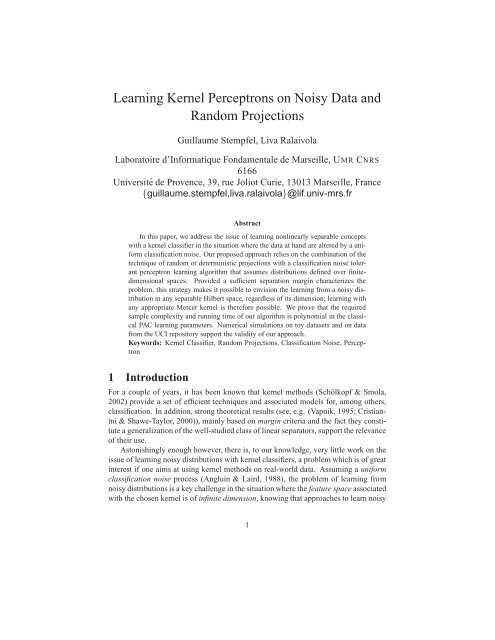
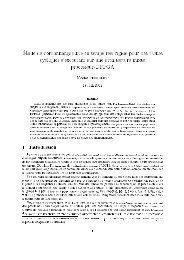
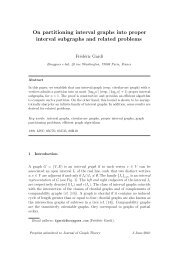

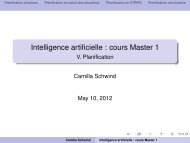

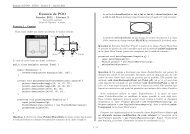
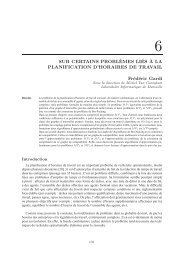
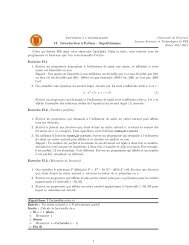
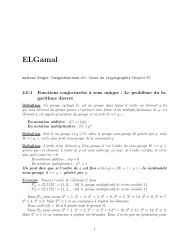
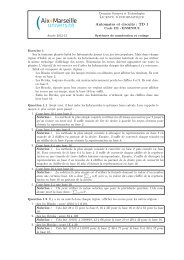
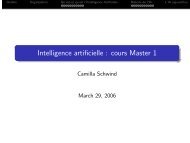
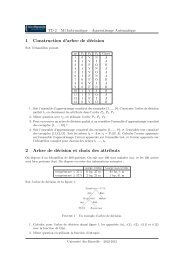

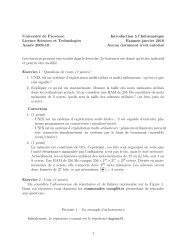
![MIPS/SPIM Reference Card (PDF) [Waetzig]](https://img.yumpu.com/41288532/1/184x260/mips-spim-reference-card-pdf-waetzig.jpg?quality=85)